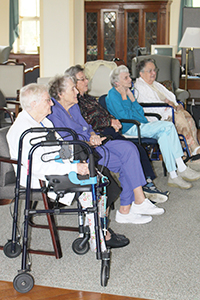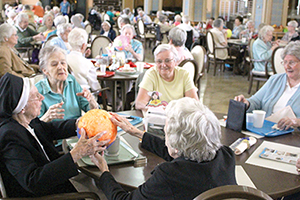A goal is to help women, men religious safely live where they want to, for as long as possible
By JULIE MINDA
The median age of the Sisters of St. Joseph of Brentwood, N.Y., is 81.
"So, health issues along with the dynamics of healthy aging are a major concern for us," said Sr. Helen Marie Kearney, CSJ, president of the congregation of 481 sisters.

Sisters of St. Joseph of Brentwood, N.Y., gather in the community room at the convent at their motherhouse. The congregation used a tool kit developed by the Avila Institute of Gerontology to assess its preparedness for its aging members' needs.
The Sisters of St. Joseph are among the dozen-plus religious communities that have used a tool kit from the Avila Institute of Gerontology of Germantown, N.Y., to evaluate the health status of their aging community members, document how their health needs are being met, anticipate emerging needs, identify gaps in care and determine how to fill the gaps. The tool they and others used during a pilot phase now is available to religious communities nationwide at no cost. The 54-page guide is called "Care Transitions Assessment: A Community Tool for Assessing Care Concerns." It is available online at avilainstitute.org.
Sr. Kearney said, "Many sisters have strong attachments in the places where they live and are committed to aging in place. Where it is possible and safe, we want to support that desire. When it is neither, we want to be prepared with appropriate settings for the sisters."
She said the assessment tool is helping the congregation to do that.
Soup to nuts
Created by staff, board members, consultants and affiliates of the Avila Institute, the assessment tool is like a workbook that congregation leaders can fill out to get a comprehensive picture of their members' needs. Headed by Sr. M. Peter Lillian Di Maria, O CARM, the Avila Institute is the educational arm of the Carmelite Sisters for the Aged and Infirm of Germantown, which sponsors, co-sponsors or serves in 19 long-term care facilities in the U.S., and one in Ireland.
The institute's new guide includes assessment worksheets on a community's demographics, members' health status, the level of care that members with special needs may require, supportive services available locally and actual and potential funding sources for care.
In the health assessment section of the guide, communities score the health status of the members who have the most pressing health concerns. That section asks about mental, neurological, orthopedic, renal, endocrine and cardiovascular functions and other aspects of health.
The level of care section asks for a rating of members' proficiency with activities of daily living, such as bathing, dressing, eating and taking medications. The support services section asks if certain services are required — for instance, home health, counseling or nutrition services — and then asks how those services currently are being provided. The funding section asks whether funds are available from Medicaid, Medicare, private insurance, grants or other sources to pay for the care. The section on the current accommodations of members asks about the presence of good lighting, grab bars, emergency call lights, ramps, handrails and the like.
Taking stock
According to information from the National Religious Retirement Office of the United States Conference of Catholic Bishops, "there are more than twice as many religious past age 70 as under. By 2026, it is projected that religious past age 70 will outnumber those under age 70 by roughly four to one."
Carole Stathis is an elder care consultant, Avila board member and one of the developers of the tool kit. She said the living environments of many congregations "were not designed to provide for the needs of aging members with a wide range of chronic conditions, including sensory issues, mobility issues, memory issues, cardiac conditions, pulmonary challenges and the dangers of polypharmacy, to name a few."
Stathis added, "Many religious communities do not have members who have the expertise to identify projected needs over the next five to 10 years of their members as they continue to age." Many lack financial resources and are unaware of services and funding available to help them care for their membership.
Sr. Kearney added, "Health care and all the funding sources that support it are changing so rapidly that it really requires those intimately involved in it to keep up with what is current and viable for religious congregations today."

Sisters of St. Joseph of Brentwood, N.Y., play a "pass the piñata" game at their motherhouse. The congregation is using insights from the "Care Transitions Assessment: A Community Tool for Assessing Care Concerns" to prepare for the sisters' needs as they age.
She said the tool kit is a teaching device to help congregations "be aware of things that you were not as conscious of before. Nuns are famous for 'making do,'" but they shouldn't take that approach in areas that impact health and safety, she said.
Proactive planning
Sr. Di Maria said congregations that do not assess members' needs and prepare likely will face challenges quicker than they expect. When members begin experiencing health crises, it "is the worst time to make decisions."
Avila board member Ann Spenard helped develop the tool. She is vice president for operations for the Qualidigm health care consulting firm. She said the assessment will help communities create a strategic plan for managing the needs of their frail elderly and aging populations.
Michelle Pandolfi, another Avila board member and tool developer, noted that religious communities can and should use the tool every several years as members' health status changes. Pandolfi is executive director of Thrive at Home with Whitney Center, a division of a continuing care retirement center.
Holistic view
Br. Mark Knightly is the interim administrator of St. Joseph Center, the elder care community for brothers and priests with the Moreau Province of the Congregation of Holy Cross in upstate New York. That congregation piloted the tool to assess the needs of the 35 Holy Cross brothers and priests living at St. Joseph (about 100 other Moreau Province Holy Cross community members live elsewhere in the U.S.).
Br. Knightly said the tool gave him a holistic view of the needs of the brothers and priests and challenged the community's leaders to think creatively about how to meet those needs. Citing the saying "If the only tool I have is a hammer, everything looks like a nail," Br. Knightly said Avila's assessment guide "puts many more tools in the box."
Sr. Kearney's congregation's use of the tool gave planners new insights about caring for all of the sisters — some of them live in a skilled nursing facility at the motherhouse, some in a convent at the motherhouse, some in another Long Island convent, still others live in small groups in other convents or apartments. Sr. Kearney said the tool gave congregational leaders concrete information on the general health of members and information on what likely is ahead.
She said leadership determined by using the tool and consulting with Avila through a contract relationship that the congregation had to hire more professional caregivers and change some staffing patterns. "It meant hiring lay women to take major responsibilities for our care. This was a big step for us but one that has been a real gift and grace."
Spenard, one of the tool developers, said, "The hope and the dream is that these communities will have the infrastructure in place, so (their members) can live out their lives with their family, in the environment of their choice."
Copyright © 2016 by the Catholic Health Association of the United States
For reprint permission, contact Betty Crosby or call (314) 253-3477.